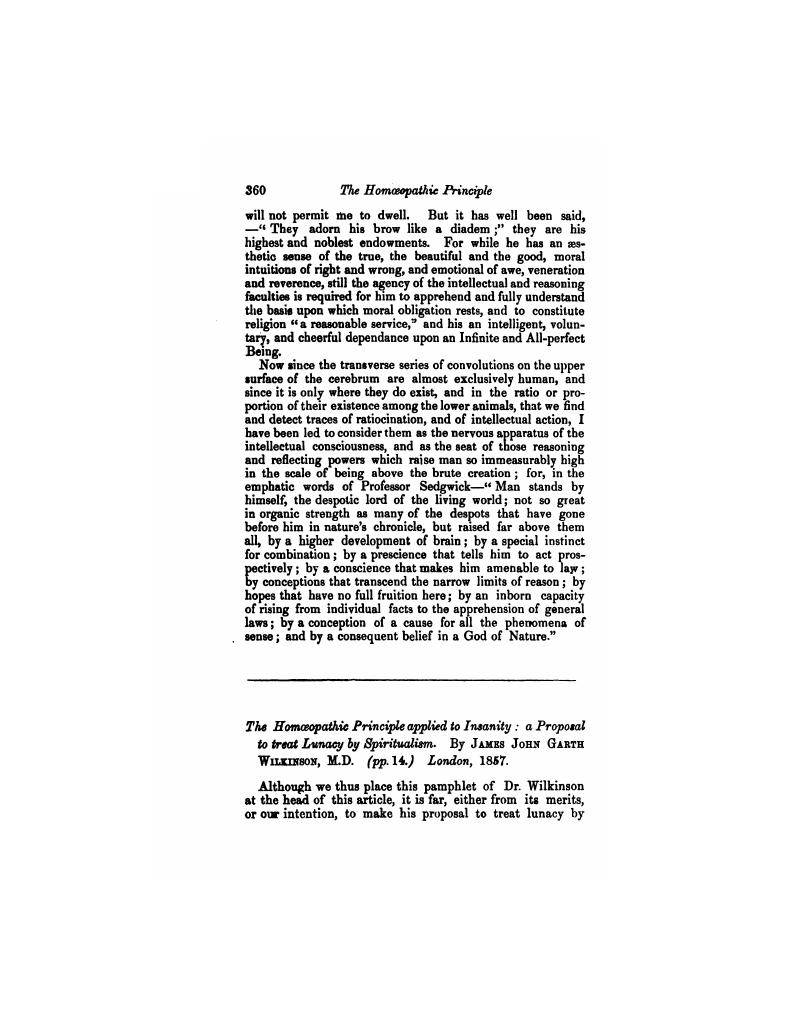No CrossRef data available.
Published online by Cambridge University Press: 02 January 2018

∗ Let no man accuse us of garbled extracts. We subjoin the warning in full:—Google Scholar “But how many, viewing the wonders of the spirit pen and pencil, may say it is the devil. Let it be judged by its works. If it effects a general madhouse delivery, the Lord and Heaven are the Doer. His name be praised. The devil would like the credit of such a work, but he shall not have it. The routine and officiality which stood against such a result, would be his easy chair.Google Scholar “Routine will indeed have a very changed time of it, from the moment when insanity begins to be treated on the spiritual plan. For then cure will be within hail; and although the deep ocean has comparatively few duties, and the deck is lazy then, yet when we come near the coast, skill begins again, anxious nights, looking out ahead, heaving the line, and sighting the beacons. So with the coming cure. It will come in crises and exasperations preliminary to recovered sanity. Crisis is a part of hope, and is the anxious side of it. And therefore routine will probably be unable to cope with such new hopes and fears, and will seek another berth.Google Scholar “And indeed when the new machinery is at work, the amount of supervision necessary, the constant call upon skill and sympathy, and the amount of presence of mind demanded, will be incalculable compared to the present conditions. All the madness will be on the move, struggling, fermenting, heaving with sanity. The asylum, no longer a swamp of incurables, will be a burning fiery furnace in which souls and minds are being purified. One of the busiest scenes probably on earth : holding intercourse and commerce with the invisible; as it were a collective apparition of the Saviour, stimulating and yet stilling the transactions and the pulses of a newly-established centre of the all-communion, and mart of many nations! Whoever is not prepared for hope, velocity, and the skill born a full-armed out of the top-head of human affection, will have to clear out of the way of this movement, which will be too much for him; and he, too little for it.Google Scholar “Enough has been said to project the idea, which is an immortal idea, given for dominion by and by. It is at once a deduction of science, a fruit of experience, and a living inspiration.”Google Scholar
∗ This gentleman is a brother of the author of the pamphlet at the head of tills article.Google Scholar
∗ i.e., the artist states that on placing her hand on another piece of paper, without any act of volition or conception on her part, that she wrote one by one the colors to be employed in the paintings.Google Scholar
∗ We have in confidence communicated the names here referred to, to the Editor of this journal. Our readers will find several detailed exposures in the article in the Westminster, for January, 1858 (p. 53, et seq.) to which we have already referred.Google Scholar
∗ Spirit Manifestations; by John Snaith Rymer. London, 1857.Google Scholar
∗ Since writing the above, we have met with the following passage in Mr. Buckle's recent History of Civilization in England, which we earnestly commend to the consideration of those who, like Mr. Rymer, believe in the power of super natural agency to influence the mechanical laws which regulate the movements of their chairs and tables, and other fixed bodies. Yet surely it is sad here, in the middle of the nineteenth century, to have thus to argue for the truth of the most simple laws of dynamics:Google Scholar “It is evident,” says Mr. Buckle, “that a nation perfectly ignorant of physical laws, will refer to supernatural causes all the phenomena by which it is surrounded. But so soon as natural science begins to do its work, there are introduced the elements of a great change. Each successive discovery by ascertaining the law which governs certain events, deprives them of that apparent mystery in which they were formerly involved. The law of the marvellous becomes proportionately diminished; and when any science has made such progress as to enable those who are acquainted with it, to foretell the events with which it deals, it is clear that the whole of those events are at once withdrawn from the jurisdiction of supernatural, and brought under the authority of natural powers. The business of physical philosophy is to explain external phenomena, with a view to their prediction; and every successful prediction which, is recogenized by the people, causes a dissolution of one of those links which, as it were, bind the imagination to the occult and invisible world. Hence it is, that supposing other things equal, the superstition of a nation must always bear an exact proportion to the extent of its physical knowledge. This may, in some degree, be verified by the ordinary experience of mankind. For if we compare the different classes of society, we shall find that they are superstitious in proportion as the phenomena with which they are brought in contact, have or have not been explained by natural laws.”Google Scholar
∗ February 20th, 1858.Google Scholar